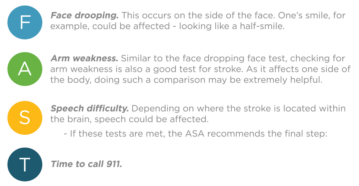The thought of having a loved one who suddenly suffers a stroke can be quite terrifying to comprehend. Fortunately, there are facts about the nature of strokes that are readily available and can be conveyed simply. These may provide a sense of comfort through understanding why strokes occur, what the effects may be, and the treatment available.
A stroke, as defined by the American Stroke Association (ASA), occurs when a blood vessel transporting oxygen to the brain either clots or ruptures. Most blood clots are natural following an injury or cut where we bleed. The clots act as helpers agents that stop bleeding. However, blood clots become dangerous when they form without an injury pretense. Without the flow of blood, the brain cells begin to die.
A clotted stroke is known as an ischemic stroke, and one with a rupture is called a hemorrhagic stroke. The latter may be caused by both aneurysms and arterial malformations, also known as AVMs. An aneurysm occurs when a blood vessel balloons in size in an isolated location, often leading to a swift and brutal onset headache. These may not always rupture and could leak or simply remain ballooned in size, leading to localized pain in one’s face or numbness on one side of the face. AVMs are seen when blood vessels form incorrectly. The exact cause of AVMs is still somewhat unknown, though many attribute it to a genetic disorder.
Symptoms of both ischemic and hemorrhagic strokes are observed by the ASA as following an acronym F.A.S.T:
The symptoms depends on which section of the brain where the stroke occurs—hence why strokes can be referred to as “left-brain” or “right-brain.” As the neural pathways within the brain form connections with the opposite side of the brain, the same can be said for strokes. If the stroke occurs on the left side of the brain, the right side of the body is physically affected and vice versa.
Treatment for a stroke varies with the affected individual. With half of a body at a physical disadvantage due to the stroke, sessions of physical therapy (PT) and occupational therapy (OT) are crucial for recovery. Physical therapy works to strengthen the affected side, utilizing all sorts of exercise equipment, including the NuStep. Occupational therapy involves re-integrating the activities of daily life (ADLs), such as dressing, eating, and interacting with a home environment. The ArmeoSpring is designed to help isolate wrist and arm movement through video-motion gameplay, and is a popular device in OT programs.
Beyond physical and occupational therapy, another crucial part of stroke recovery is assessing to what degree speech or cognition might be affected. Conditions that arise related to these include apraxia, aphasia, and ataxia.
- Apraxia is a condition that affects the body’s to execute movements, including speech. For example, the word “coffee” might be pronounced “coff-uh” or “coff-oo” in an individual with apraxia.
- Aphasia can impede an individual’s ability to say a specific word (saying something they didn’t mean to such as “spoon” for “fork”), or form longer sentences. Similarly, one’s reception of longer sentences or figurative language may also be hindered.
- Ataxia arises from injury to the cerebellum and results in disorientation. This includes unbalanced gait and hand coordination.
Should a loved one suffer a stroke, they are not alone. There are numerous resources to help guide patients and their families through the process of recovery. Click here to read stories of hope from stroke survivors.
Categories: Aphasia, Brain Function, Brain Health, Brain Injury, Stroke

